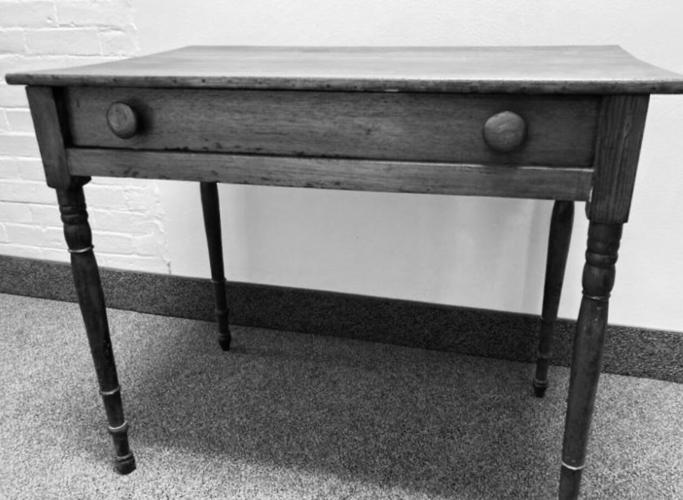BRATTLEBORO — Anthony Van Doorn moved to Brattleboro around 1815. He was in his early 20s and established a furniture-making business in town. Examples of his furniture can be found in the Bennington Museum, the Historic Deerfield Museum, and our Collection.
He married Betsey Hubbard of Groton, Connecticut in 1815. At the time, their marriage announcement stated that he was already living in Brattleboro. They went on to have five children, one of whom predeceased him, dying in 1820 at the age of 2 years.
Van Doorn opened his cabinet making business in West Brattleboro and turned out what he called “Home Manufactured Articles,” as opposed to the imported ”Foreign” furniture then popular. Whether “foreign” meant articles made in other states or in Europe is not clear, but since furniture imported from Europe would have been very expensive, he probably meant items made in neighboring states. There were many factories, especially in and around Boston, which made furniture and sold it in shops all around New England.
Van Doorn’s furniture was fashionable along the Connecticut River Valley during the first half of the 19th century. It was a blending of Sheraton, Federal and Empire styles. His business prospered, and in 1829 he moved his factory to the southwest corner of Main Street on the bank of the Whetstone Brook. Advertising pictures of his building showed it to be several stories tall with a bell tower on top. The factory was run by water power, as were most of the mills built along the Whetstone Brook.
Van Doorn expanded his business and began training his workers to handle more specialized tasks. Rather than have one man make an entire piece, a worker learned how to make one standardized item like legs, which could be turned out in less time. It also meant that if the workman was not fully trained, it was possible that not all of the legs would be exactly the same. A table donated to the Brattleboro Historical Society, made between 1836 and 1847, has four legs, all the same. Many of Van Doorn’s pieces, known as lady’s work tables, had a flat top, and one or two drawers with either wooden or glass knobs, and possibly two drop leaf sides.
The Bennington Museum displays one of his tables, with folding leaves on each side and casters (wheels) on the legs. The maker's label reads: “Cabinet making by A.Van Doorn, Brattleboro, Vt. all kind of furniture, chairs, looking glasses, feathers, coffins and grave stones on the best terms.” It seems that his company could provide items for the house, the funeral, and the cemetery.
Van Doorn developed machinery to help in the manufacturing process. He was able to standardize production and build furniture for various price points. Over the years, he had partners: William A. Conant, who became a successful violin maker; his brother Frederick; and sons, Moses, and Charles. From 1847 to 1851 they manufactured items under the company name of Van Doorn & Sons.
Van Doorn advertised for workers in the Vermont Phoenix on several occasions. Many apprentices, young men between 15 and 16 years of age, passed through his doors, living and working under his roof. They were taught the skills needed to create chairs, tables, cabinets and other furniture.
At one time, Van Doorn’s “cabinet-making” business was the largest furniture-making factory in Vermont. For example, in 1850 he employed 18 workers who were learning the “cabinet-making” trade. Throughout the years, these young men often went on to work for other furniture companies or to start their own businesses. When Anthony Van Doorn retired, after nearly 40 years of furniture-making, he stated that the many apprentices who learned their trade from him were now operating about 100 cabinet shops across the country.
In 1850, Van Doorn built, on the opposite side of Main Street, and slightly north of the factory, a three and one-half story brick Greek Revival style house still known as the Van Doorn Building. His family lived downstairs and the upper floors were tenement apartments. This building is one of the oldest structures on Main Street. Fires wiped out most of the early wooden buildings on both sides of Main Street, but the Van Doorn building survives to this day.
Van Doorn retired from business in 1851 and turned the business over to his sons. By 1853 they had sold the furniture factory. After his retirement, Van Doorn lived for another 20 years. A highlight of his retirement was an eight month tour of Europe.
In 1857 the former Van Doorn wooden factory building burned to the ground in a spectacular fire. Sixteen buildings along the west side of Main Street were destroyed, including the first Estey Organ shop and Vinton’s paper mill. More than 100 people lost their jobs and/or their housing as a result of this devastating fire. The Van Doorn lot was left vacant until 1875, when the brick Wilder Building was erected.
Anthony Van Doorn died in Providence, Rhode Island on August 21, 1871, aged 79, while visiting his son. The coroner reported that he died of a heart attack. One paper said he had not been feeling well before going to Providence but continued with his visit nonetheless. His wife, Betsey (Hubbard) Van Doorn died in Brattleboro on September 20, 1875, aged 85. Both are buried in Prospect Hill Cemetery, along with their five children.
This article was researched by Brattleboro Historical Society Secretary Carol Farrington.









